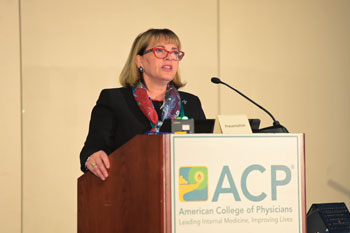Sorting through the science of PSA screening
An expert clears up issues surrounding prostate cancer screening recommendations at Internal Medicine Meeting 2022.
Alex Sankin, MD, MS, understands why internal medicine physicians might find prostate cancer screening recommendations confusing.
The National Comprehensive Cancer Network (NCCN), the American Cancer Society, and the American Urological Association (AUA) all recommend some form of the screening in men ages 55 to 70 years. But these groups also have many differences in their advice, especially regarding screening intensity, cutoff points for actionable prostate-specific antigen (PSA) levels, and handling of high-risk patients, Dr. Sankin said.
The U.S. Preventive Services Task Force, meanwhile, updated its 2012 recommendations in 2018, sticking with a recommendation against screening in men ages 70 years and older but newly issuing a C grade recommendation for screening those ages 55 to 69 years, meaning this group should discuss it with their doctors.
“I feel for primary care providers who are in the office with many other chronic ailments that they're treating with their patients. How do they approach PSA screening?” said Dr. Sankin, who is associate professor, associate program director, and director of the clinical trials program in the department of urology at Montefiore Medical Center and Albert Einstein College of Medicine in New York City.
As part of a session titled “Clinical Triad: Cancer Screening Updates and Controversies” at Internal Medicine Meeting 2022, he offered his audience a prostate cancer history lesson and a road map.
Years ago, two out of three prostate cancer cases were diagnosed at an advanced stage. “The digital rectal exam was the only form of early detection, and most men died of prostate cancer after progression to metastasis,” Dr. Sankin said.
The landmark study supporting PSA screening was published in April 1991 in the New England Journal of Medicine, he said. It looked at the effects of screening in 1,653 men ages 50 years and older. Those whose PSA level was greater than 4.0 ng/mL went on to receive a digital rectal exam and a transrectal ultrasound, then a biopsy if findings were suspicious. The results were compared with those in a control group of 300 men who had undergone ultrasound-directed biopsy due to symptoms or an abnormal digital rectal exam.
“What they found is that there was a drastically increased rate of detection of prostate cancer in the screen group, and one out of three cancers in this group would have been missed without the PSA,” Dr. Sankin said. “And remarkably, advanced disease was only seen in 3% of the screen group versus 20% of the control group.”
The success of PSA screening lies in the biology of prostate cancer, Dr. Sankin explained. In the disease's earliest stages, the basal cell layer of the prostate gland is lost, and cells begin releasing PSA into the bloodstream. This is when tests can pick up an increase in PSA level.
“Then, as the cancer progresses, you start to develop signs and symptoms, which could be an abnormality on rectal exam or urinary symptoms, and then eventually the cancer gets to a point where it metastasizes and can cause death,” he said. “So in the pre-PSA era, we were picking up prostate cancers when they were later on in the disease progression.”
PSA screening can offer a lead time of five to 10 years, which Dr. Sankin called “a hypothetical window of opportunity” for catching and treating early-stage disease. After PSA screening was adopted in the 1990s, prostate cancer detection shot up. “So then, of course, the question is, all right, we're detecting prostate cancer, but does PSA screening save lives?” Dr. Sankin said.
To answer that question, he pointed to two trials. In the Prostate, Lung, Colorectal, and Ovarian Cancer (PLCO) Screening Trial, which assigned 76,693 men to receive annual screening with PSA testing or digital rectal exam or to usual care, screening did not appear to reduce prostate cancer death at seven to 10 years of follow-up, according to results published in the New England Journal of Medicine in March 2009.
However, Dr. Sankin said, this trial had a very high contamination rate. Many men in the control group were also receiving PSA screening, and 50% of the men selected had had PSA screening in the past. “So even though this trial was intended to be a trial of screening versus no screening, in reality, it was a trial of a lot of screening versus some screening,” he said. “And not surprisingly, there was no reduction in mortality.”
The second trial, the European Randomized Study of Screening for Prostate Cancer (ERSPC), was also published in March 2009 in the New England Journal of Medicine. It assigned 162,243 men to PSA screening once every four years or control and found a 20% reduction in prostate cancer mortality in the screening group. However, the number needed to screen to save one life was high, at 1,400, because most of the cancers detected were low risk, Dr. Sankin said.
“Now that it's been a while since these studies have concluded, there's been a number of different re-analyses and extended follow-ups, and the general consensus is that there's probably about a 25% to 30% reduction in prostate cancer mortality with PSA screening,” he noted.
But while data show that PSA screening saves lives, the potential harms of overscreening also need to be considered, Dr. Sankin said. He reviewed some of the strategies he uses in his practice to help with patient and physician decision making on this issue.
Early PSA testing, or obtaining a baseline PSA at a younger age, may help determine who is more likely to develop prostate cancer later in life, Dr. Sankin said. A study published in the Journal of Clinical Oncology in February 2007 looked at 21,277 men who had their first PSA test before age 50 years and found that those with a level of 1.0 ng/mL or higher were at greater risk for prostate cancer over their lifetimes. “However, a diagnosis of prostate cancer does not mean inevitable death from prostate cancer,” Dr. Sankin said. “So that brings us to the next question: Does PSA in young patients predict risk of prostate cancer death?”
To answer that, Dr. Sankin reviewed a study published in September 2010 by BMJ of 1,167 men who had a PSA test at age 60 years. Those with a PSA level of 2.0 ng/mL or more were 13 times more likely to be diagnosed with prostate cancer, 17 times more likely to have a prostate cancer metastasis, and 26 times more likely to die of prostate cancer. The findings indicate that 90% of deaths from prostate cancer occur in men whose baseline PSA level exceeds 2.0 ng/mL in their 60s, he noted.
“I like to use this study as kind of justification for if I have a man in my practice, and he's in his 60s and the PSA is 2.0 or less, I think it's reasonable to talk about stopping screening at that point, or at least lowering the intensity of screening, not doing it every year,” Dr. Sankin said. “It's kind of a gray area, and I like to have a discussion with my patient about that.”
PSA is very sensitive for detecting prostate cancer but not very specific, especially for high-grade disease, Dr. Sankin noted. As a result, “there's a number of different reflex tests on the market now, reflex meaning you have an elevated PSA, so you would then reflexively order another test.”
The one he uses most often is the 4K score, a blood test that looks at four different PSA isoforms and determines a patient's likelihood of having high-grade prostate cancer. “I like the 4K score because it comes up with a report card that's really easy to use when you're counseling patients,” Dr. Sankin said. “In the report card, they kind of classify based on your percentage as low risk, intermediate risk, or high risk.”
In a validation study published in European Urology in August 2015, men with a low-risk 4K score had a 2% chance of prostate cancer metastasis at 20 years. “That's pretty reassuring,” Dr. Sankin said. He noted that while the 4K score can reduce unnecessary biopsies by 30% to 60%, it can miss about 1% to 5% of high-grade cancers.
To detect high-grade cancers, multiparametric MRI can be used as an add-on to PSA, Dr. Sankin said. Eighty percent of prostate cancers detected with the aid of pre-biopsy MRI will be high-grade versus 45% of those biopsied without MRI, he noted, although 5% to 10% of patients with a negative MRI will have significant invisible cancer.
MRIs before biopsy are endorsed by the AUA, the European Association of Urology, and the NCCN, Dr. Sankin said. “In my practice, and as far as I know it's going on nationwide, MRIs are almost being done universally prior to biopsy.”
Dr. Sankin concluded his talk by stressing that universal screening for prostate cancer without patient counseling should be abandoned. “Two golden rules I like to follow are ‘Do not screen men who won't benefit,’” he said, “and ‘Do not biopsy without a compelling reason.’”




